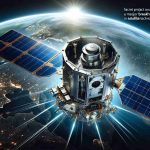- Researchers are focusing on Earth’s microorganisms to guide the search for life beyond Earth.
- Chemotaxis, the movement of microbes toward attractants, could signal potential life on other planets.
- Microbes like Bacillus subtilis and Haloferax volcanii show a strong response to L-serine, indicating a method for life detection.
- Experiment results reveal that microbes can effectively swim towards attractants, providing a practical approach for future missions.
- This method is affordable and adaptable for exploration of harsh environments, like the icy moons of Europa.
- This research could transform our understanding of life in the universe and potentially answer if we are alone.
What if the universe’s biggest secrets about life beyond Earth lie not in distant galaxies but in the tiny, bustling world of microbes? For decades, our fascination with extraterrestrial life has led us to scan the stars, but researchers in Germany are now shifting their focus closer to home, using Earth’s resilient microorganisms as a roadmap for discovering alien life.
Imagine a world where chemotaxis—the spontaneous movement of tiny organisms—becomes a beacon guiding us towards potential life in space. Scientists have observed that familiar microbes, such as Bacillus subtilis and Haloferax volcanii, respond excitedly to the amino acid L-serine. This movement could hold the key to detecting life on other planets, including Mars.
In an eye-opening experiment, these hardy microbes were placed on one side of a simple experimental setup, while L-serine was introduced on the opposite side. The results were astonishing; the microbes swam eagerly toward the attractant, revealing a straightforward yet effective approach to life detection. This method is not only affordable but also suitable for future space missions, offering hope that we can detect life in even the harshest environments.
As we prepare for the next wave of exploration across icy moons like Europa, this innovative microbial movement technique could revolutionize our methods for finding life. Imagine unveiling secrets hidden beneath layers of ice, igniting a new chapter in our quest for understanding the cosmos.
With this exciting research paving the way, we may soon be equipped to answer one of humanity’s oldest questions: Are we alone in the universe?
Revolutionary Microbial Discoveries: The Key to Finding Alien Life?
The New Focus on Microbes in the Search for Extraterrestrial Life
Recent advancements in microbiology and astrobiology are indicating that the search for extraterrestrial life may not lie solely in distant galaxies but within the resilient and adaptable microorganisms that thrive in extreme environments on Earth. Research from Germany has highlighted how chemotaxis, or the movement of microorganisms towards chemical attractants, can provide groundbreaking insights into the detection of life beyond our planet.
# How Microbial Movement Works
Microorganisms like Bacillus subtilis and Haloferax volcanii have demonstrated a remarkable ability to respond to the amino acid L-serine. In experiments, these microbes were able to move towards L-serine, suggesting that similar biological responses could serve as potential markers for life on other planets such as Mars. The principle is that if life exists elsewhere, it may react in the same way to specific chemical cues.
# Innovative Detection Methods for Future Missions
This research suggests a practical and cost-effective method for detecting life, potentially applicable for future extraterrestrial explorations. The experimental setup, which showcases how microbes can be used as biosensors, offers a promising avenue for astrobiologists to employ these techniques in missions to icy worlds like Europa or Titan, where conditions may be hostile yet conducive to life.
Key Insights and Predictions
1. Affordability and Accessibility: This microbial detection method is not only economical but can be adapted for use in a variety of space missions, allowing for widespread application in astrobiology.
2. Expanding Our Understanding of Habitats: By studying extremophiles—organisms that live in extreme conditions—scientists can gain insights into the potential for life in similar environments across the universe.
3. Potential for New Discoveries: As technological advancements continue to improve our exploration capabilities, the combination of microbial studies and robotic space exploration can drastically enhance our ability to identify habitable conditions beyond Earth.
Important Questions About Microbes and Extraterrestrial Life
# 1. How can chemotaxis help in the search for life on other planets?
Chemotaxis helps identify life by demonstrating that organisms will respond to chemical attractants like L-serine. If similar processes occur on other planets, they could guide scientists toward biosignatures indicative of life.
# 2. What are the implications of using Earth microbes in space exploration?
Using Earth microbes can streamline and economize life detection processes, helping us quickly ascertain the presence of life in extreme environments, which mirrors conditions on other celestial bodies.
# 3. What are the limitations of microbial detection methods?
While microbial methods are promising, they rely heavily on the assumption that life beyond Earth would behave similarly to known life forms on Earth. The variability in alien environments may pose challenges in accurately interpreting results.
Conclusion
As we delve deeper into Earth’s microbial life, we may not just uncover how life thrives in extreme conditions but also unlock potential pathways to discovering life beyond our planet. The focus on microbial chemotaxis could fundamentally reframe our search for extraterrestrial intelligence, promising exciting possibilities for future discoveries.
For more information, visit NASA.




















